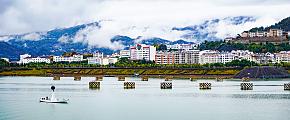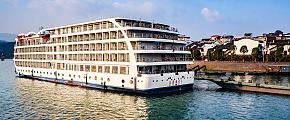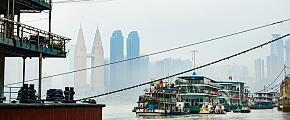Spectacular Mountainous & Landscape of Yangtze River
The Three Gorges is a splendid scenic spot of unparalleled natural wonder, but this area has more than just natural beauty, it has amazing and ancient folk traditions as well. Excursions on the following must be great fun.
Tujia Ethnic Minority
The Tujia ethnic minority group is one of China's 55 ethnic minorities and the largest minority group in the Yangtze River area. Their arts, crafts, and folk traditions have greatly influenced the area. Tujia women are very good at weaving. They weave cloth on simple wooden looms set up in their homes. Their weaving is simple, yet beautiful. Tujia brocade is reputed to be one of the most famous brocades in Southwestern China. According to Tujia tradition, young Tujia girls will start learning knitting at the age of eleven, or twelve.
The marriage customs of the Tujia are unique in China. According to tradition half a month before the wedding ceremony the new bride should weep. Her weeping shows that the bride is virtuous. Young Tujia girls actually start to practice their weeping when as young as 15 years old. The family will invite an experienced"Weeping" instructor to their home to teach her. Girls will hold weeping competitions and discuss methods of weeping.
Another interesting Tujia custom is the funeral dance. When an elderly Tujia person dies, he/she will be put in a coffin in the main room of the house for one to three days. Every night male friends and relatives will dance for the deceased. One person beats a drum while the others dance together. The drummer sings songs commemorating the dead. It is said that singing and dancing help lift the pall of grief for the family of the deceased.
Fishing on the River
Traditionally people in the Yangtze River area made their living off the river. Fishing has been one of the main sources of income for thousands of years. The small wooden boats, or sampans, used by the fishermen are about 4 meters in length, and a meter wide. The fishermen live aboard their boats. In the past, the boats were powered by sailor manpower, but now diesel engines have replaced sail. There are usually two ways in which these fishermen catch fish: net casting, and hooks. During the day fishermen cast large nets that use large stones as anchors, then one or two boats working together drag the nets to catch the fish. At sunset long lines with baited hooks, spaced at intervals, are dropped into the river, and in the morning the lines are reeled in.
Boat Trackers
Another way people have made their living on the Yangtze River is by boat tracking. Even today with diesel engines, boat trackers are the only way for a boat to travel on the river. Originally boat trackers worked all over the Yangtze River, but now they are primarily located on the Shennong Stream. When one of the small river boats gets stuck on a sandbar, it is time for the trackers to jump into action. Only a few feet above the ancient waterline a thin ledge runs for several miles. It is barely 60cm wide it was cut by hand from the solid rock walls. The trackers climb onto this ledge and, by using ropes connected to the boats, tow the boats off the sandbar. Then they jump back into the boats and the boat is now free to travel on until it gets stuck again. It is backbreaking work that has remained unchanged for centuries.
Yangtze River Arts and Crafts
Sometimes overlooked by visitors mainly interested in the gorgeous scenery, the local arts and crafts along the Yangtze River are beautiful, and exclusive to this part of China.
Carving in the Three Gorges area has a long history. Traditionally carving has been used for furniture, buildings, and articles for daily use. Doors, windows, posts, and balustrades on traditional buildings are traditionally covered with carving. The carvings usually depict creatures, or items having auspicious meanings. Stone Carving is mostly seen on temples, arches, and tombstones. The local bluestone is normally used.
Yichang's painted pottery is famous throughout China. Using the local yellow mud as the base material, various kinds of highly valued painted pottery are produced. This pottery is so revered that examples of this beautiful art have been given to foreign dignitaries.
Embroidery has been an important traditional art for women living in the Yangtze River area for thousands of years. It has always been considered a necessary part of a young girl's education. A woman who is good at embroidery is thought to be virtuous. Many visitors to the Yangtze River area feel they cannot leave without bringing at least one example of the local embroidery home with them.
Quick Question
What Our Clients Say
SUBSCRIBE TO WIN A FREE TOUR
Subscribe to our newsletter for a chance to win a free 7-day Morocco tour! And more insider travel news, exclusive offers, and inspiration will be sent straight to your inbox.






